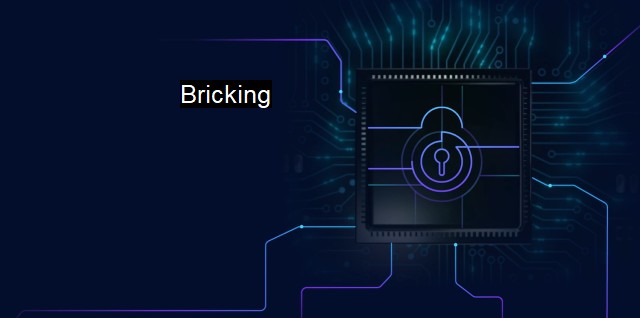What is Bricking?
Understanding Bricking: The Threat of Cybersecurity in Our Connected World
In the wireless and technology universe, "bricking" refers to a situation where a device is entirely non-functional, and its functionality is reduced to that of a brick, hence the name. It can no longer serve its initial purpose, and it has become as useful as a mere decoration or paperweight. This term, initially associated primarily with consumer electronics like game consoles and smartphones, has made its way into the realm of cybersecurity and antivirus software, wherein a device becomes virtually useless due to malware or harmful software.Understanding what bricking is necessitates a discussion on why it happens and the science involved. bricking occurs due to risks such as misconfiguration, inadequate updates and upgrades, harmful malware attacks, or even user behavior. When these risks are realized, the functioning software or operating system in devices can potentially be corrupted or damaged beyond repair. The device in effect ceases to work, making it 'bricked.'
A key factor that sometimes results in bricking is the flawed updates or upgrades to an operating system. if a firmware upgrade goes awry—for any reason—during the updating process, problems could ensue leading to bricking. Incorrect or interrupted firmware upgrades can cause software corruption, which inhibits the normal booting process of the device. A device can also be rendered useless because of hardware failures. software-related issues are usually the primary culprits in a bricking episode.
Bricking has further been classified into two categories; soft and hard bricking. Soft bricking refers to the scenario wherein a device fails to boot or function normally due to software dysfunction, and it may show a boot loop, a frozen screen, or a black screen when you turn it on. The consolation here is that a soft-bricked device can often be recovered. Some steps involve flashing the device with factory images or using software to repair the corrupted files.
On the other hand, hard bricking is akin to a death sentence for the device. This situation happens when the bootloader—the program that loads the device's operating system —is corrupted or erased. Corrupted bootloaders usually result from interruptions during firmware updates or installations. When your device is hard-bricked, it may not even turn on, and fixing it could require physical repair, or even more drastically, hardware replacement.
In the context of antivirus, bricking is a serious concern as well. Some malware can exploit system vulnerabilities and modify or corrupt the running software or operating system, eventually causing a device to brick. Conversely, an antivirus program can sometimes cause bricking when it returns false positives and deletes or quarantines critical system files. This scenario further complicates the issue, as ideally, antivirus software should provide solutions to system threats rather than add to present problems yet another layer of complexity and danger.
The emergence and evolution of gunslinger malware strains, such as NotPetya and Bad Rabbit, are also worth mentioning here. These destructive programs can brick devices by rewriting the computer's master boot record (MBR)—rendering it unable to start up, or encrypting all the files to take control of the system completely. It proves that destructive and malicious software can employ bricking as their endgame, causing catastrophic losses for individuals or corporations.
While the most effective deterrent against bricking is prevention, including security awareness and proper system management, the ability to recover from such incidents is also essential. Regular data backups, secure and convenient system restoration methods, could be some potential solutions to mitigate and manage the damage that follows a bricking episode.
Bricking is a multifaceted issue that can moot a device, hence its name. It results from several factors, such as flawed firmware upgrades and malware and even false positives from antivirus software. An understanding of bricking is beneficial to grasp the importance of effective cybersecurity management systems and antivirus solutions because, with the fluidity that characterises the technology sphere, bricking is a persistent menace that requires persistent defenses.

Bricking FAQs
What is bricking in cybersecurity?
Bricking refers to a situation when a device becomes completely unusable due to a malicious software or virus, rendering it as useful as a brick.Can antivirus software prevent bricking?
Antivirus software can detect and remove malware that may cause a device to brick. However, prevention is the best approach, and users should avoid downloading any suspicious files or clicking on links from untrusted sources.Is bricking reversible?
In some cases, bricking can be reversed by restoring the device to its factory settings or using special software. However, in other cases, the damage may be permanent, and the device may need to be replaced.How can I protect my device from bricking?
Keeping your operating system and antivirus software up to date, avoiding suspicious downloads or links, and taking regular backups of important data are all important steps to protect your device from bricking. Additionally, you should only download software or firmware updates from official sources.Related Topics
Software updates Firmware updates Vulnerability management Malware protection Data backup
| | A | | | B | | | C | | | D | | | E | | | F | | | G | | | H | | | I | | | J | | | K | | | L | | | M | |
| | N | | | O | | | P | | | Q | | | R | | | S | | | T | | | U | | | V | | | W | | | X | | | Y | | | Z | |
| | 1 | | | 2 | | | 3 | | | 4 | | | 7 | | | 8 | | |||||||